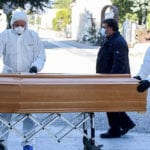 Our World
Our World  Our World
Our World  Pop Culture
Pop Culture 10 Incredible Female Comic Book Artists
 Crime
Crime 10 Terrifying Serial Killers from Centuries Ago
 Technology
Technology 10 Hilariously Over-Engineered Solutions to Simple Problems
 Miscellaneous
Miscellaneous 10 Ironic News Stories Straight out of an Alanis Morissette Song
 Politics
Politics 10 Lesser-Known Far-Right Groups of the 21st Century
 History
History Ten Revealing Facts about Daily Domestic Life in the Old West
 Weird Stuff
Weird Stuff 10 Everyday Products Surprisingly Made by Inmates
 Movies and TV
Movies and TV 10 Actors Dragged out of Retirement for One Key Role
 Creepy
Creepy 10 Lesser-Known Shapeshifter Legends from Around the World
 Our World
Our World 10 Science Facts That Will Change How You Look at the World
 Pop Culture
Pop Culture 10 Incredible Female Comic Book Artists
 Crime
Crime 10 Terrifying Serial Killers from Centuries Ago
Who's Behind Listverse?

Jamie Frater
Head Editor
Jamie founded Listverse due to an insatiable desire to share fascinating, obscure, and bizarre facts. He has been a guest speaker on numerous national radio and television stations and is a five time published author.
More About Us Technology
Technology 10 Hilariously Over-Engineered Solutions to Simple Problems
 Miscellaneous
Miscellaneous 10 Ironic News Stories Straight out of an Alanis Morissette Song
 Politics
Politics 10 Lesser-Known Far-Right Groups of the 21st Century
 History
History Ten Revealing Facts about Daily Domestic Life in the Old West
 Weird Stuff
Weird Stuff 10 Everyday Products Surprisingly Made by Inmates
 Movies and TV
Movies and TV 10 Actors Dragged out of Retirement for One Key Role
 Creepy
Creepy 10 Lesser-Known Shapeshifter Legends from Around the World
10 People Who Died Mysteriously Before Their Trial
Death is a natural part of life. However, the death of a suspected criminal before their day at trial is not common but also not too surprising once in a while. But multiple deaths equating to convenient kills before their trial draws suspicion. Here are 10 people who died mysteriously before their trial.
Related: Top 10 People Found Guilty At Trial Due To Surprise Evidence
10 Henry “Peg” Gilbert
In 1947, the police in Georgia, USA, were searching for a black man who was a suspect in the killing of a white man. Henry Gilbert was a 42-year-old African-American who was a successful farmer in Harris County. Police arrested Gilbert, a married father of four, and suspected him of harboring the fugitive. Gilbert had no idea what the police were talking about. The governing officials didn’t have an arrest warrant, and Gilbert didn’t even live to see the inside of a courtroom. He was killed in Harris County jail.
The chief of police claimed that he killed Gilbert in self-defense. If this were true, Gilbert must have had supernatural strength. Morticians discovered that the prisoner had a broken leg, a shattered skull, many crushed bones, and had been shot five times.
To add insult to considerable injury, police arrested his wife on the same charges. While she lived to see her attorney get the charges dismissed, it leaves us wondering why the police believed the Gilberts would be involved. Or, if the police enacted a crime and got away with the husband’s death, why risk being discovered and go after the wife?
9 Federico Garcia Lorca
Garcia Lorca wrote, “Only mystery allows us to live,” which is ironic considering how the celebrated Spanish poet died. Lorca sympathized with all political affiliations because his art, and the people his art connected him with, meant everything to him. Clashes between conservative nationalists and their opponents eventually led to the outbreak of civil war in July 1936.
Whatever Lorca’s political views, the Nationalist faction disliked him for his defense of the common people, his modernism, and perhaps above all, his open homosexuality. Nationalist forces arrested Lorca in August of that same year. The next day, officers took him away by car, stopped on a country road, and executed him.
Despite many efforts over the years, no one has ever found Lorca’s body. The grounds for his arrest are as muddy as that dusty background. It’s hard to imagine any motive except hatred.
8 Emil Hácha
Before the Second World War began, Hitler was tightening Germany’s hold over central Europe. In March 1939, Hitler summoned the president of Czechoslovakia, Emil Hácha, to a meeting in Berlin. Hitler gave Hácha two options. His country could cooperate with the German invaders, in which case Czechoslovakia could expect to retain some autonomy, or the Czechoslovaks could resist and face the consequences.
The German army was ready to begin its advance, so Hácha had to make up his mind quickly. He saw no alternative and agreed to cooperate with the Germans by telephoning Prague and issuing orders that the people should not resist. Hitler installed Hácha as the president of the German Protectorate of Bohemia and Moravia. As the war went on, Hácha’s role became increasingly nominal. However, he remained convinced that he had done the best thing for his people.
It was not a view that the Soviets shared. The Red Army liberated Prague in May 1945. The new authorities arrested Hácha on May 13 and sent him to prison. He died while awaiting trial on June 27. How he died is unclear. His family and many historians believe that the Soviets assassinated him.
7 Syama Prasad Mukherjee
Syama Prasad Mukherjee was an Indian politician in the early 20th century and a member of Nehru’s cabinet. In the early years of Indian independence, the political scene was tumultuous, and Nehru and Mukherjee fell out over a pact between India and Pakistan. In 1951, Mukherjee founded a party that was the direct predecessor to today’s powerful Bharatiya Janata Party (BJP).
Mukherjee was strongly opposed to a law that stopped Indian citizens from settling in the disputed region of Kashmir. In May 1953, he tried to enter Kashmir illegally. The authorities arrested him and sent him to prison. He soon fell ill, and a doctor prescribed a drug that Mukherjee said was not suited to him. The doctor administered it anyway. Shortly afterward, Mukherjee died of a heart attack.
There are still rumors that Nehru ordered his death, murdering him before he could stand trial.
6 Abu Nidal
Abu Nidal was a man who believed in the efficacy of direct action. He did not believe that a solution to Palestine’s problems could come through negotiation. His real name was Sabri Khalil al-Banna. Abu Nidal means “Father of Struggle.”
After splitting from Yasser Arafat’s faction within the Palestine Liberation Organization, Nidal formed the Abu Nidal Organization. The name reflected his personality because Nidal had to be at the center of every operation. That his group was responsible for terrorist attacks all over the world is beyond doubt. However, it is difficult to be sure exactly what the group’s involvement in many atrocities was. Nidal claimed responsibility for actions that he probably had little or nothing to do with.
Nidal was most likely connected with the bombing of Pan Am Flight 103 over Lockerbie, Scotland, in 1988. In 1999, Muammar Gaddafi expelled Nidal from Libya in an attempt to distance the country from any involvement. In 2002, Nidal was living in Iraq, where the U.S. was gearing up to invade.
Intelligence agents went to arrest Nidal at his house in Baghdad. According to the head of Iraqi intelligence, Nidal asked if he might change his clothes before they took him away. Here’s where the story diverts. Some sources say he went into his bedroom and shot himself. Different sources claim that there was a gunfight between Nidal’s men and the agents. Others say that he was executed in cold blood because Saddam Hussein was worried that if the U.S. invaded, Nidal would collaborate with the Americans.
5 Melissa Caddick
When a foot washed up on Bournda Beach in New South Wales, Australia, it was quickly identified as belonging to Melissa Caddick. This was in February 2021. The previous November, Caddick disappeared.
The day before she vanished, police and federal agents raided her home near Sydney, searching for evidence that she had misappropriated some $30 million from investors in a Ponzi scheme. From 2012 until 2019, people, including her family and friends, thought that they were making secure investments with Chaddick, who, in fact, was depositing the money in 37 different bank accounts and using it to fund a luxurious lifestyle. She fobbed off her clients with fake statements that she herself produced from a genuine, reputable online stockbroker.
Once her operation came under the scrutiny of the financial authorities, Chaddick left her house the day after the home search and never surfaced again. The discovery of the foot suggests a myriad of options, from suicide, murder, or even Chaddick faking her own death to throw authorities off her scent.
If a one-footed Australian woman tries to convince you to make an investment, be careful.
4 Lee Bradley Brown
British citizen Lee Bradley Brown died in custody in Dubai. He made a last-minute decision to take a holiday at the prestigious Burj al Arab hotel, and what exactly happened in his room remains in considerable doubt. The hotel staff said that a maid entered his room but didn’t warn Brown, nor was she wearing a uniform or carrying any identification. The staff claimed that Brown abused the maid and tried to throw her from the internal balcony. Staff tried to restrain Brown, but he violently resisted even when local authorities intervened. When under arrest, Brown was charged with intimidation and using abusive language.
Brown was put in a cell with other European prisoners and seemed to get on well with them. After a trip to the prosecutor’s office, Brown returned with serious injuries and was put in solitary confinement. The chief of police stated that other prisoners had beaten Brown and video evidence could be provided to support the claim, but he never did. The officer later denied having offered surveillance and claimed Brown repeatedly threw himself to the floor and caused the injuries himself.
Brown died six days after his arrest, and there still isn’t any solid evidence on how or why.
3 Hans Kammler
Hans Kammler would certainly have stood trial as a Nazi war criminal if he had ever been found. A high-ranking member of the S.S., Kammler was a skilled engineer who contributed to various civil engineering projects, oversaw the construction of concentration camps, and ran the V-2 rocket program. This knowledge of rocketry would have made him a valuable addition to American or Soviet teams working on similar projects.
As WWII came to an end, there were conflicting reports about his whereabouts. His driver said that Kammler had died on or about May 10, 1945, but he did not know how Kammler had died. A former OSS officer claimed that the Americans had taken Kammler to the U.S., where he died in 1947. Other reports have him at different locations in and around Germany in the last days of the war.
Perhaps he died in the chaos, perhaps he went to the U.S., or perhaps he led a long life in Argentina. The fact is, he died before he ever faced any kind of court or tribunal.
2 Jeffrey Epstein
Jeffrey Epstein met his death in the Metropolitan Correctional Center in New York City while awaiting trial for sex trafficking. It wasn’t the first time Epstein faced the law for sex crimes. He was a convicted offender who was sure to get a long sentence when found guilty at this new trial.
In the days leading up to the event, officials placed Epstein on suicide watch after a guard had found him unconscious in his cell with injuries to his neck. Another inmate was supposed to share Epstein’s cell, and a guard was supposed to check on him every 30 minutes.
On the night of his death, authorities didn’t follow these procedures. They had taken Epstein off suicide watch, there was no other inmate, and no guard checked his cell. The two cameras focused on the area coincidentally malfunctioned at the time of his death, leaving the public to wonder if he killed himself or if it was a hit job to cover for those involved in his various crimes.
1 Jack Ruby
There are enough conspiracy theories surrounding the death of President John F. Kennedy, and the role of Jack Ruby adds to them. Authorities arrested Lee Harvey Oswald for Kennedy’s assassination, but Ruby shot Oswald—very publicly—before Oswald’s prosecution.
Ruby faced trial for the killing, and the court convicted him. He appealed and was granted a new trial. Ruby died of cancer before his new trial started, but some believe that the bare facts leave a lot of questions hanging in the air.
Why did Ruby kill Oswald? What were Ruby’s connections to organized crime? Why was Ruby granted a second trial? Why did Ruby die so soon after his diagnosis? All of these questions have yet to be answered.








